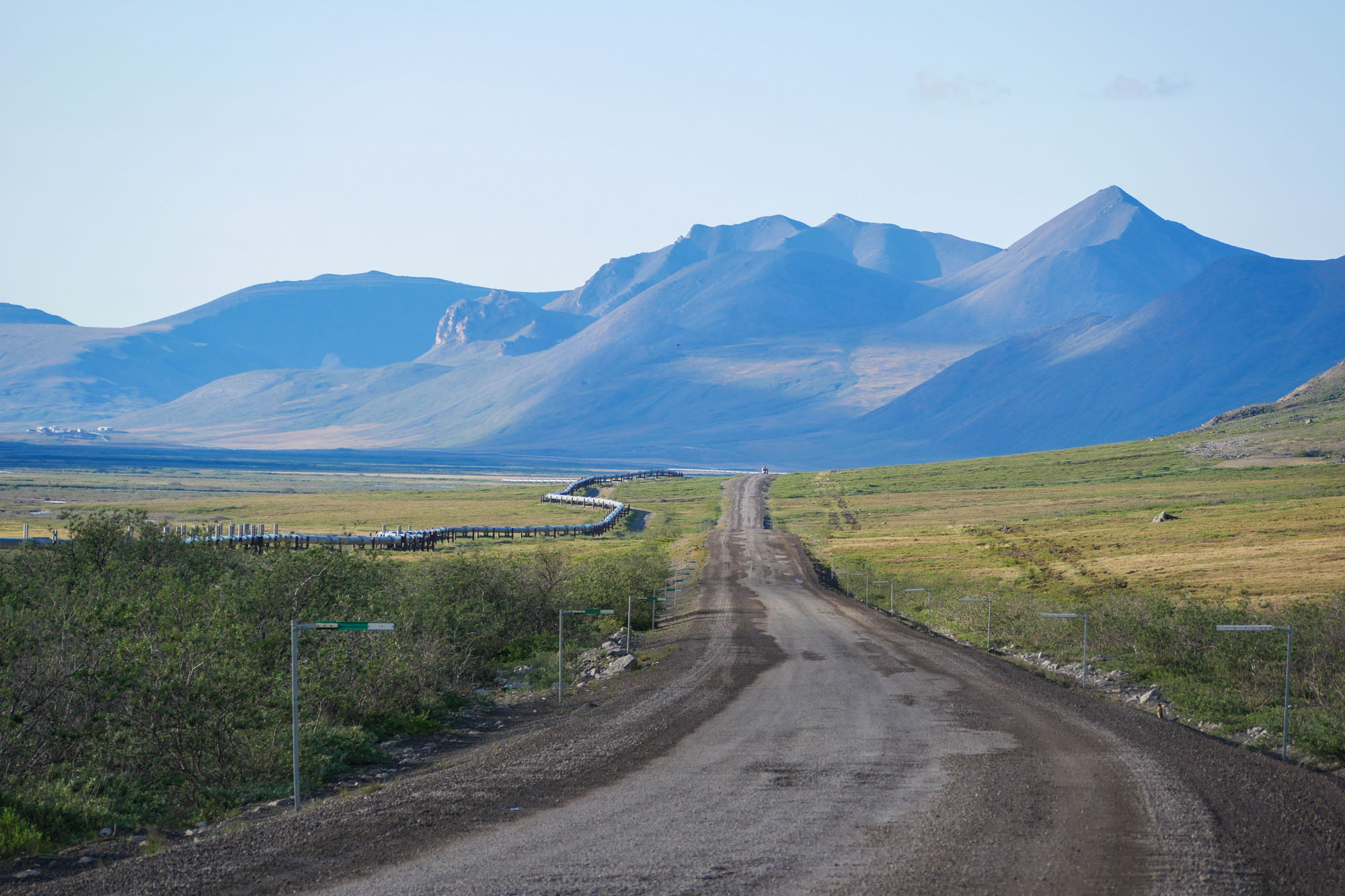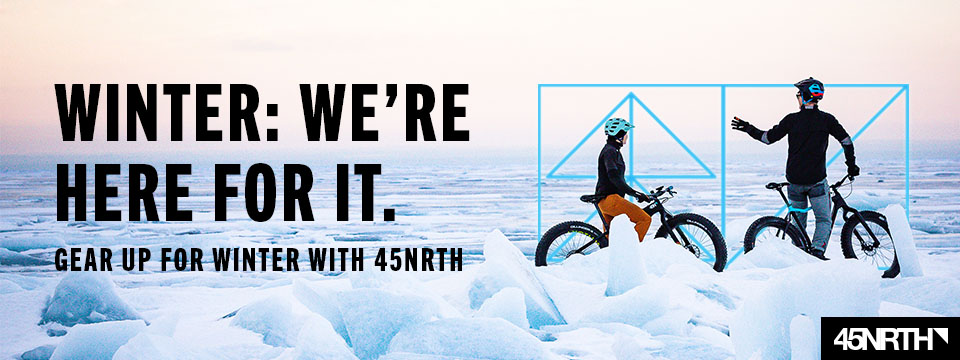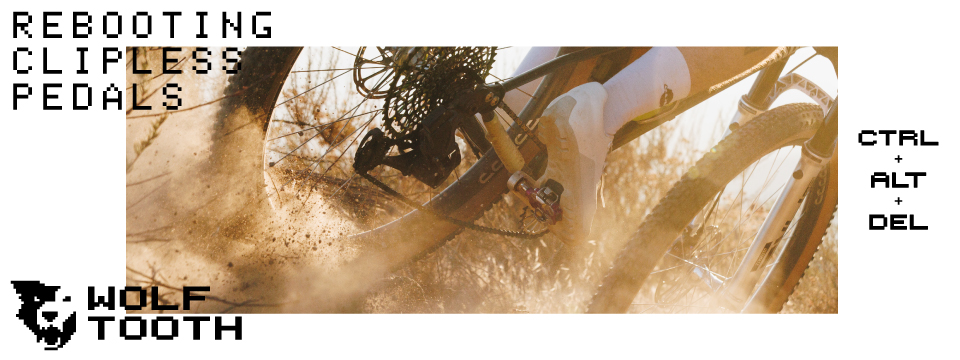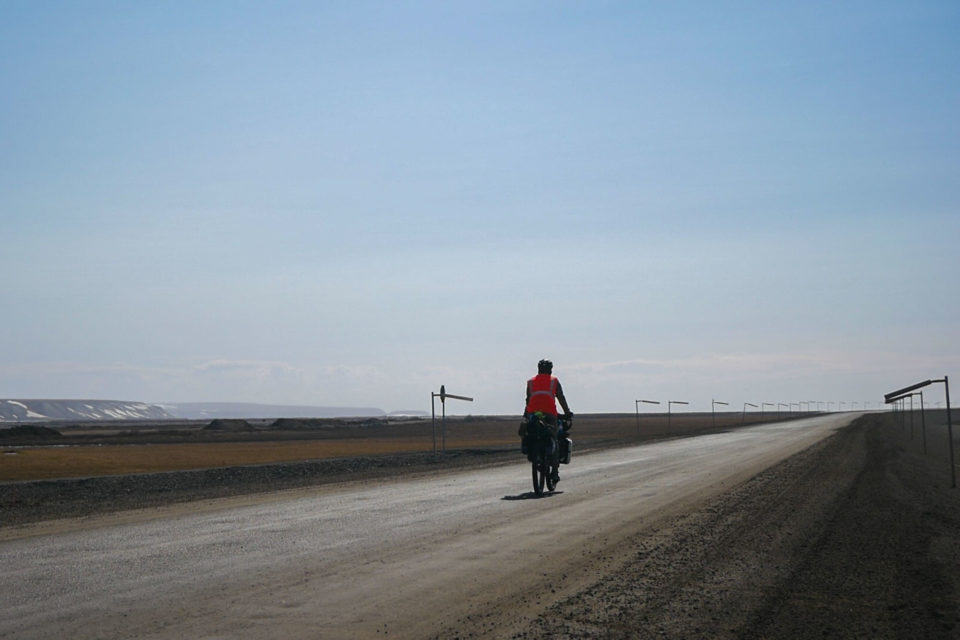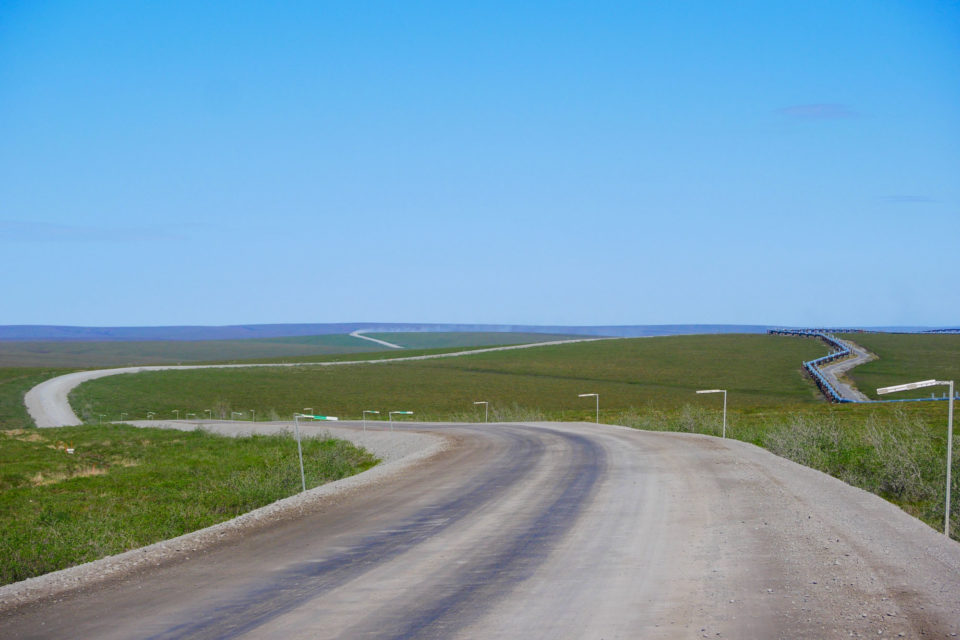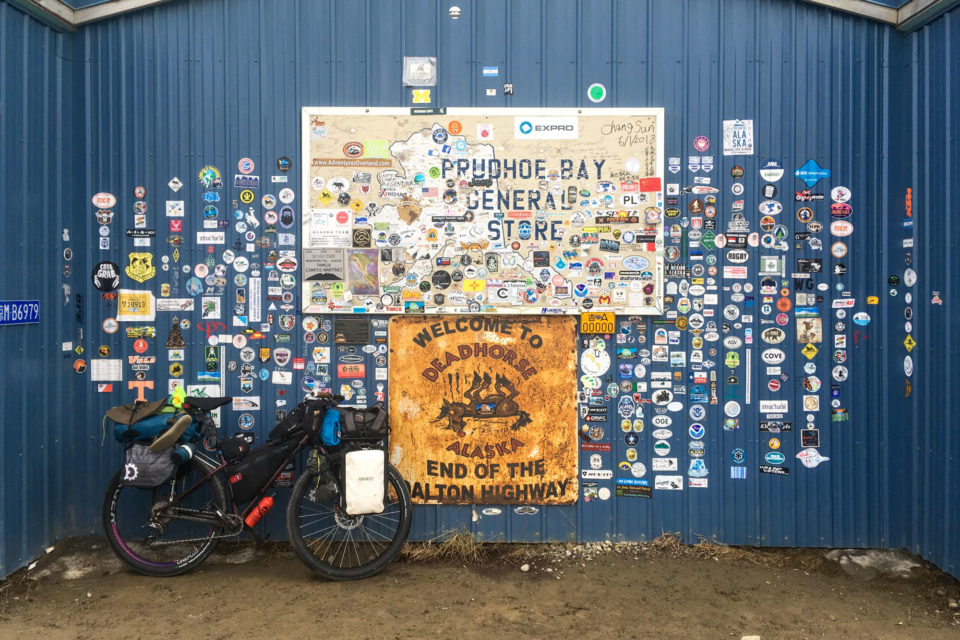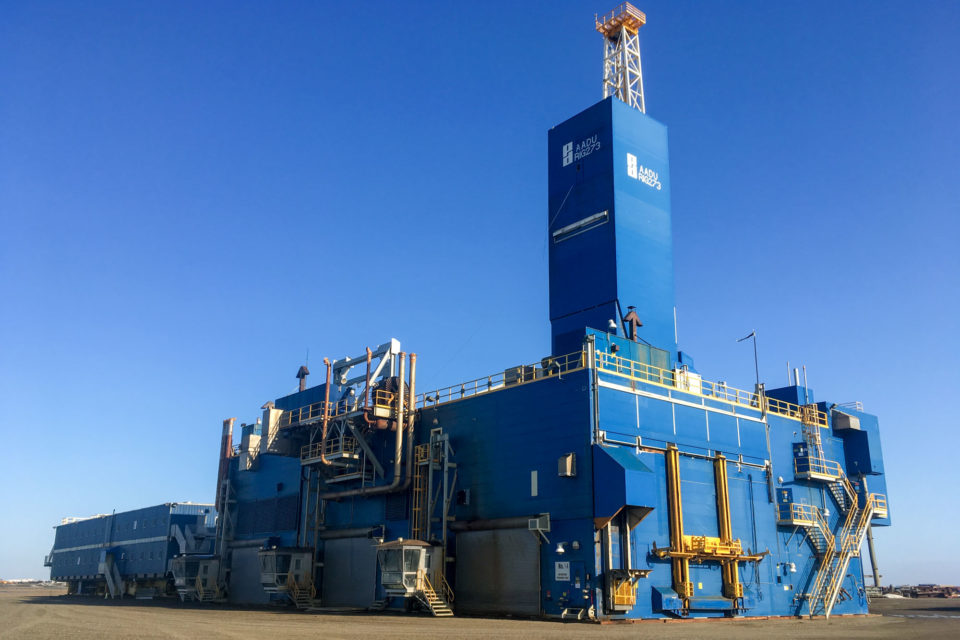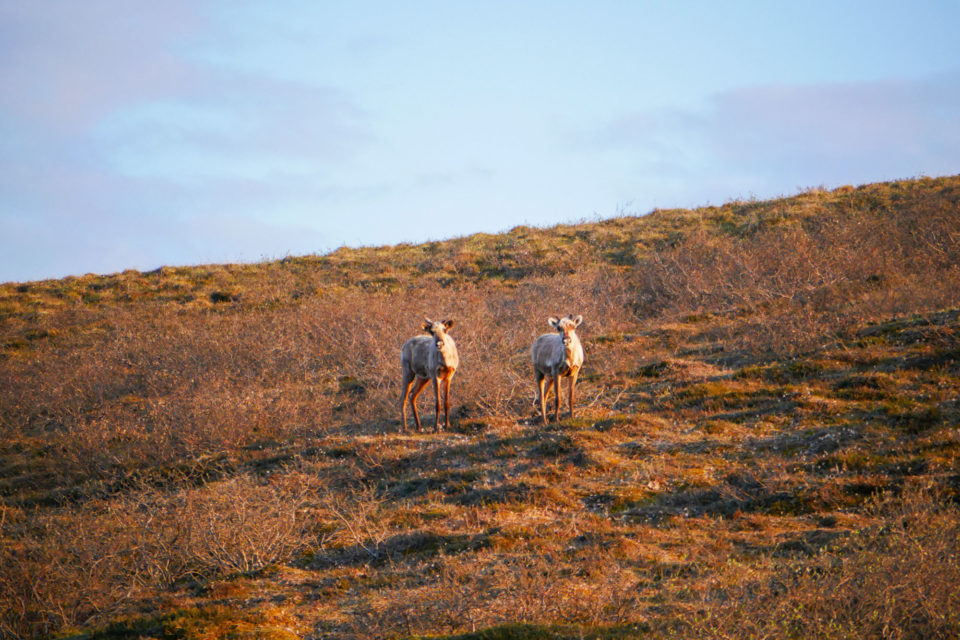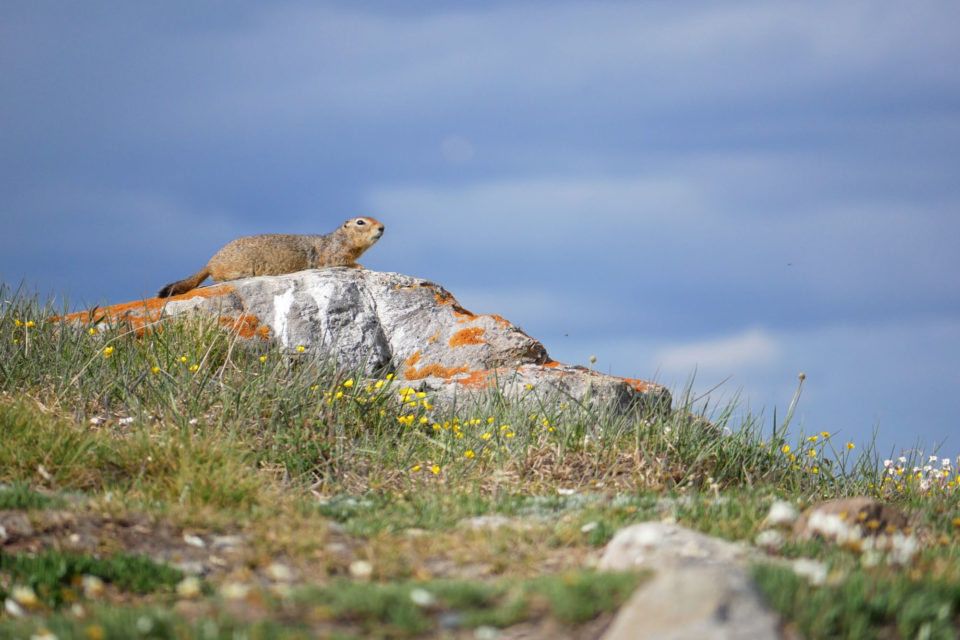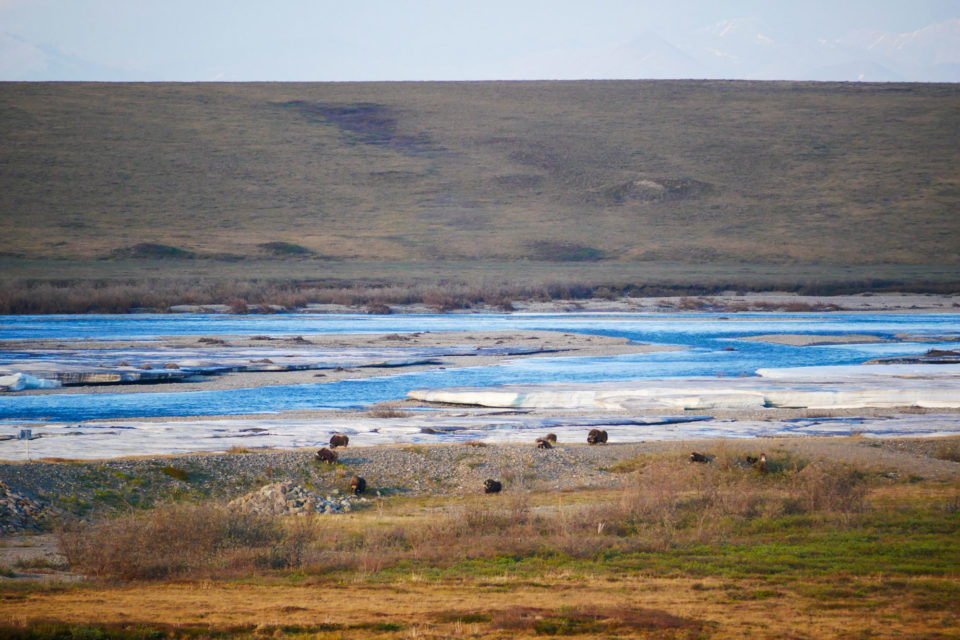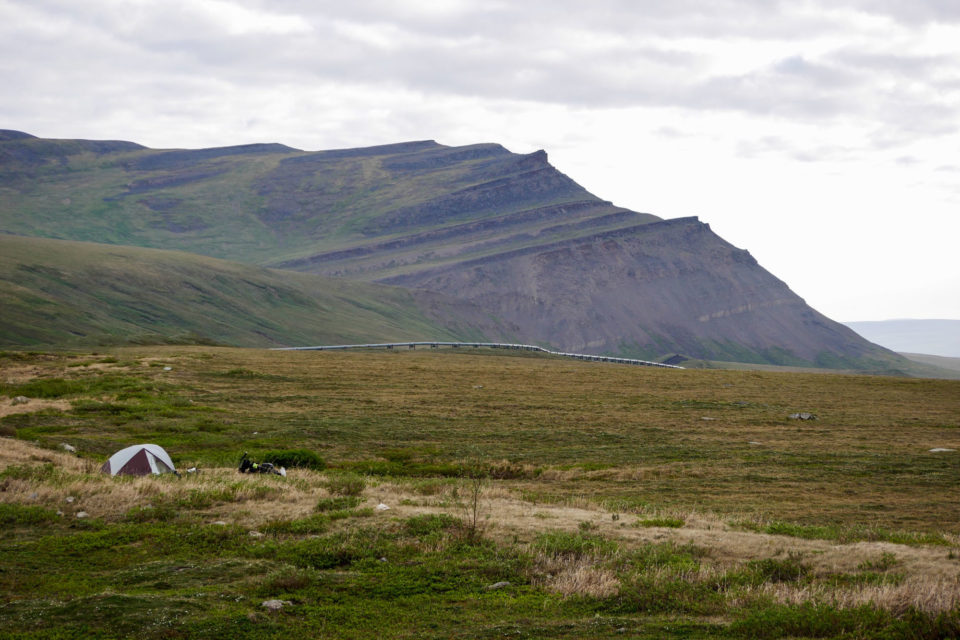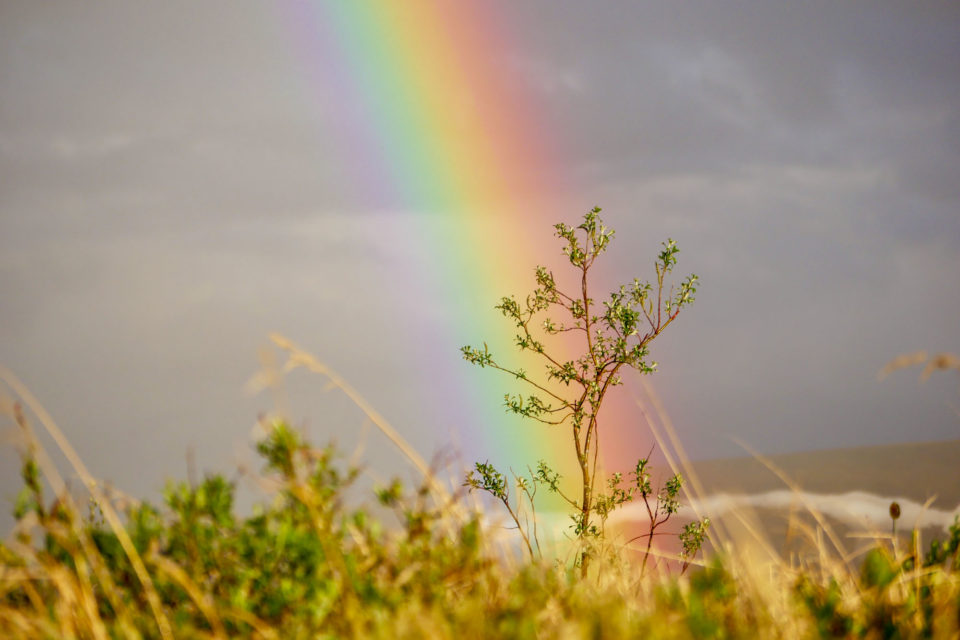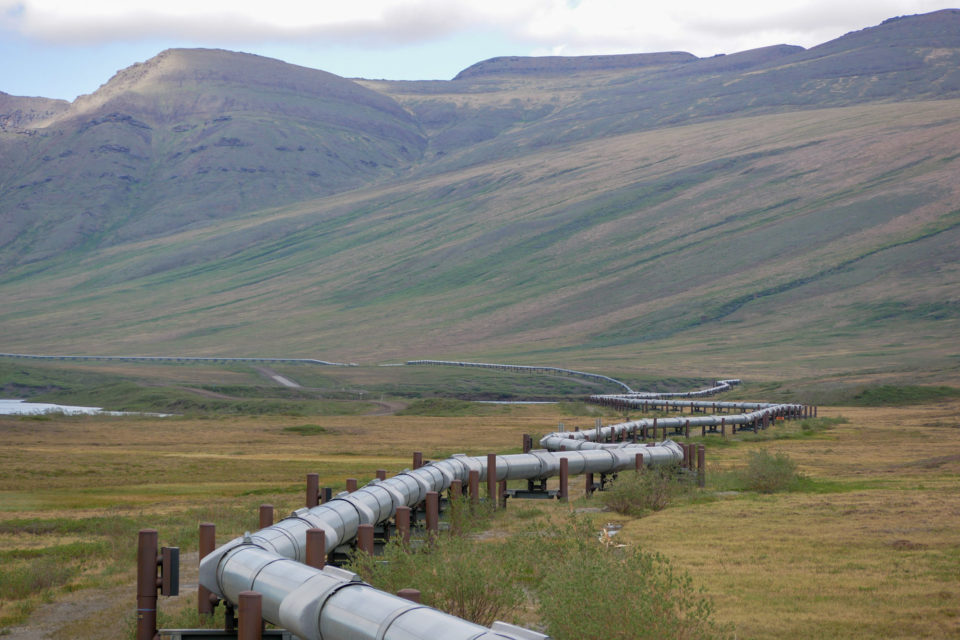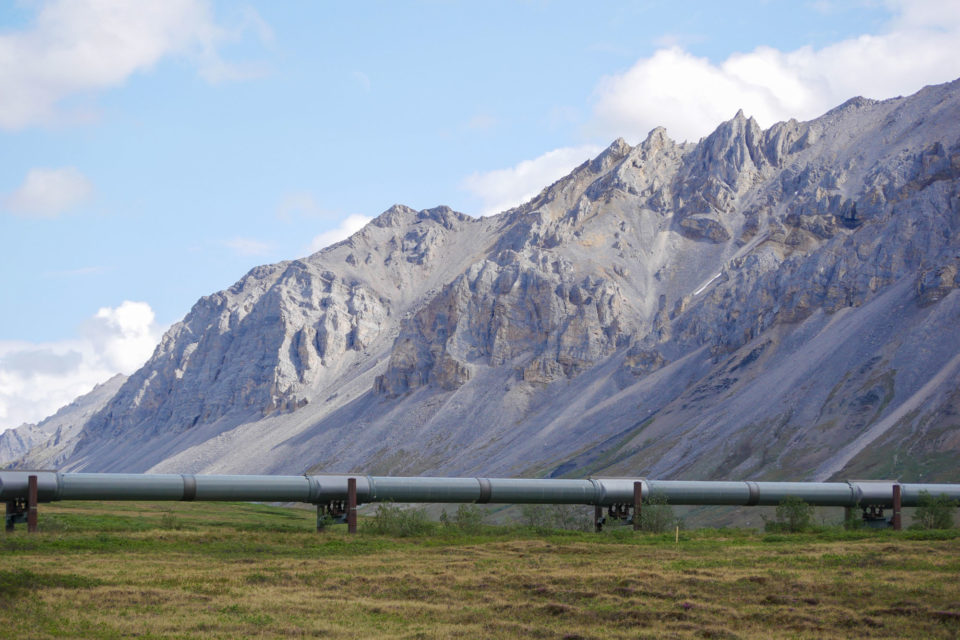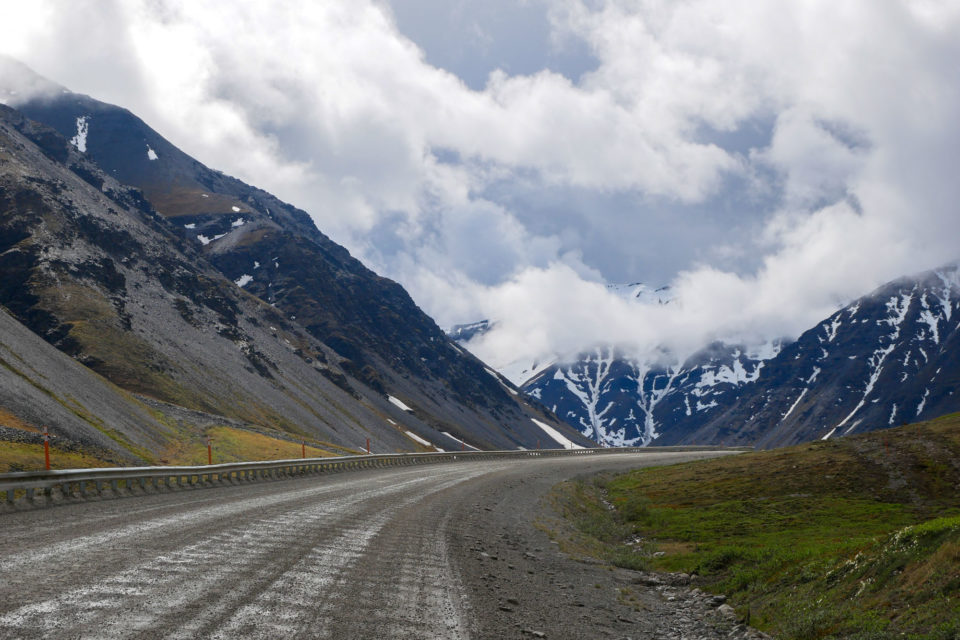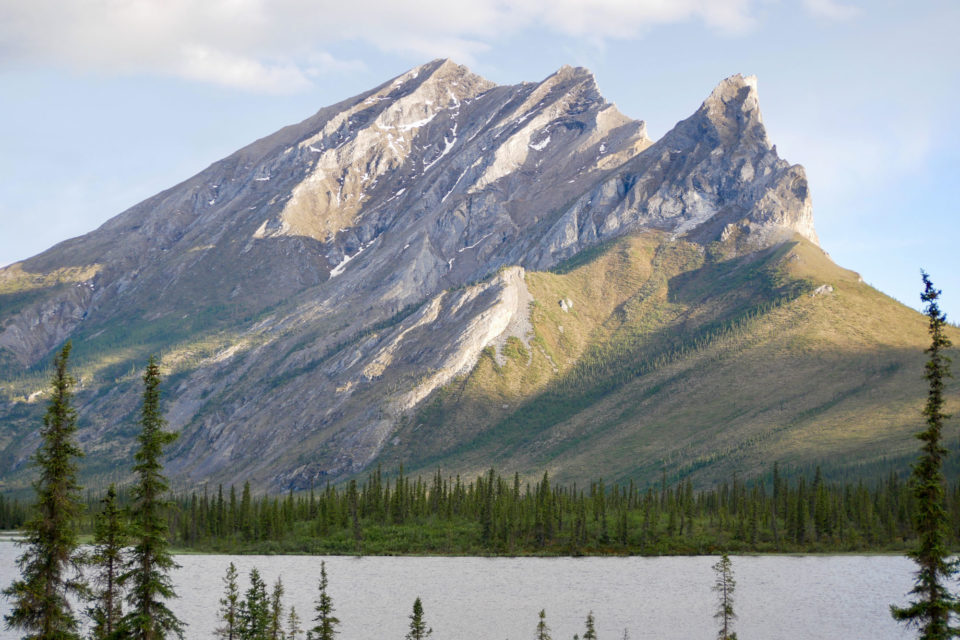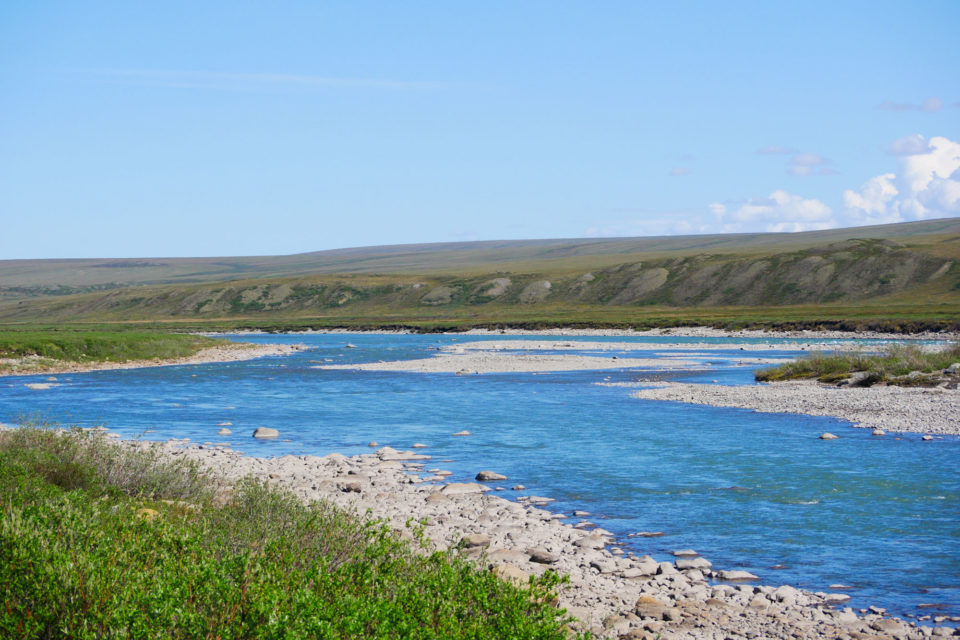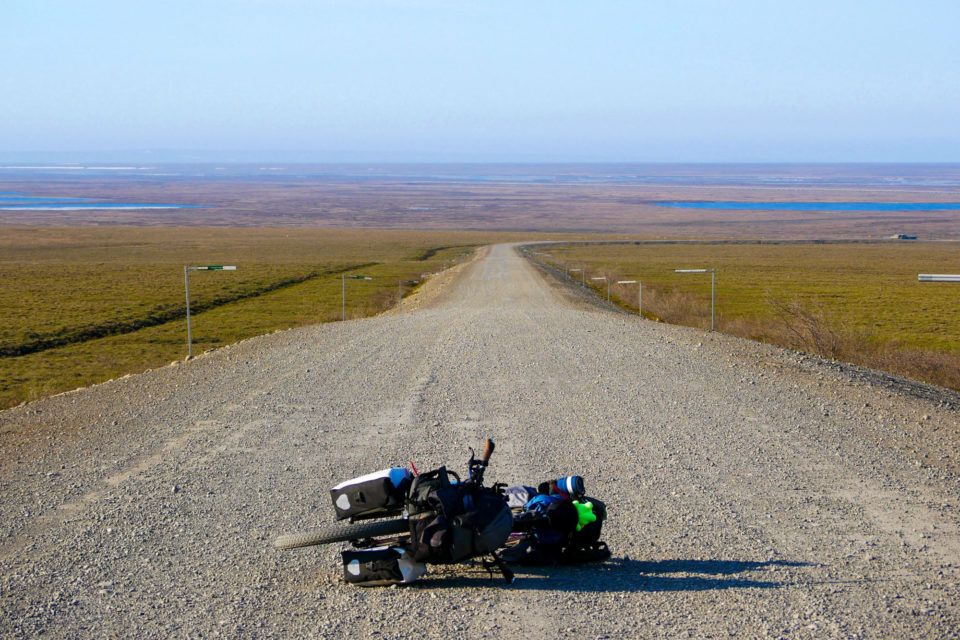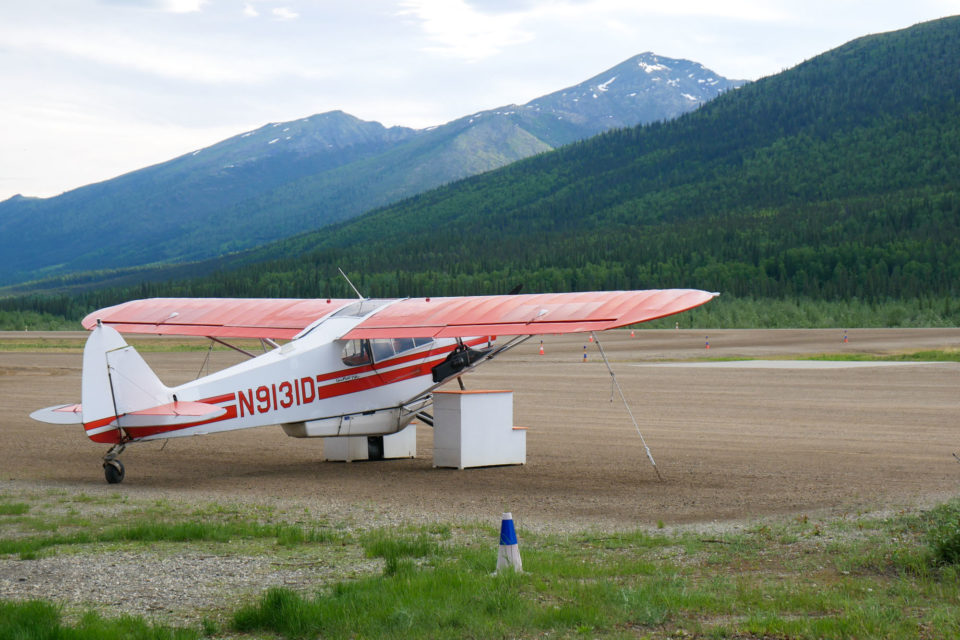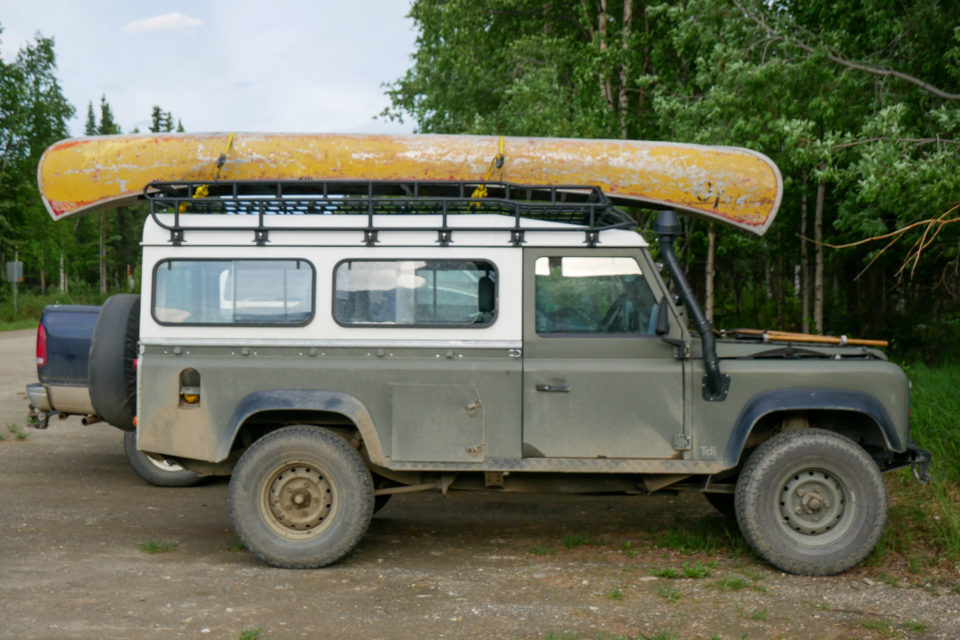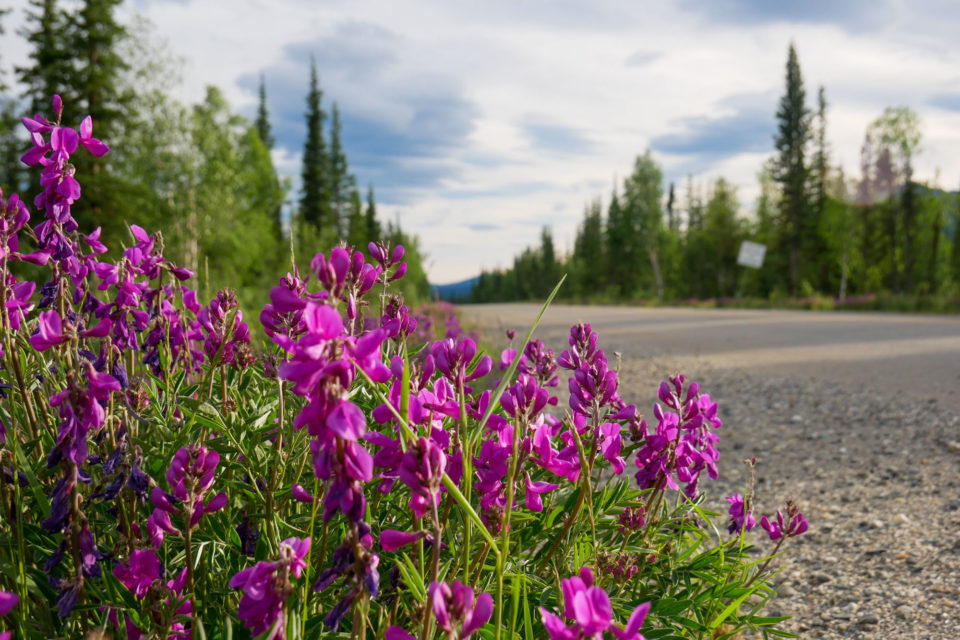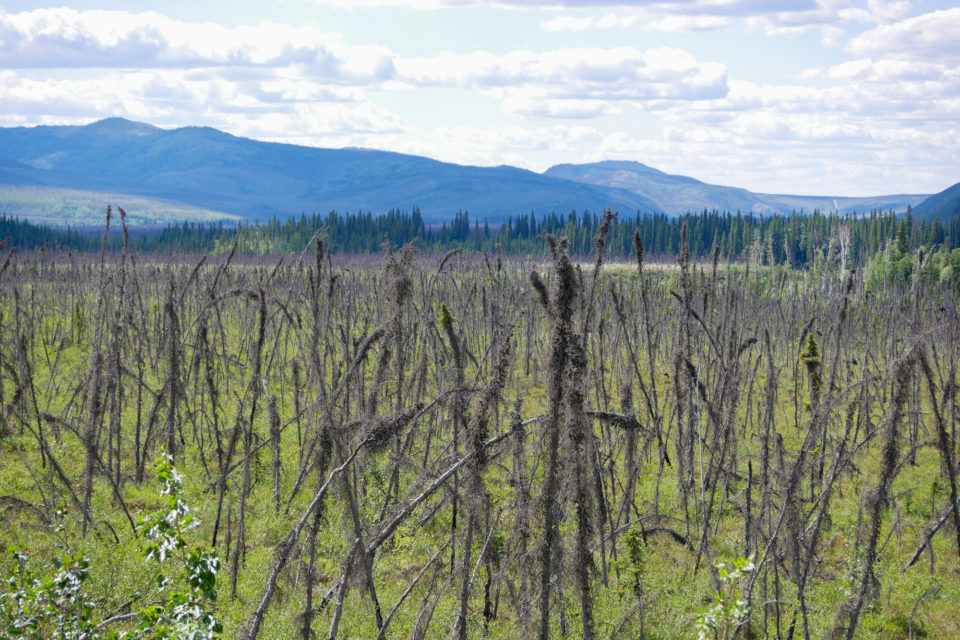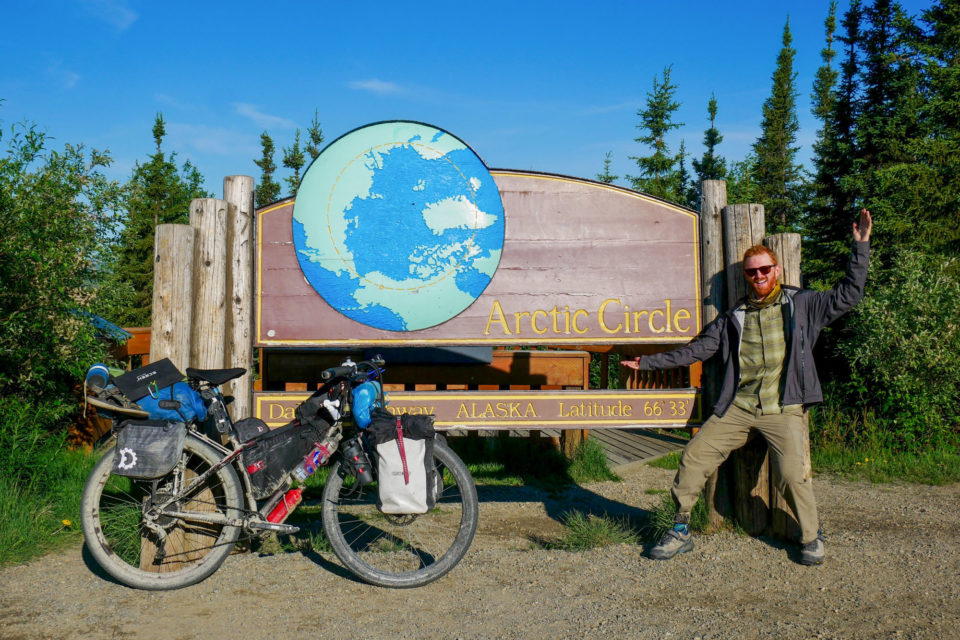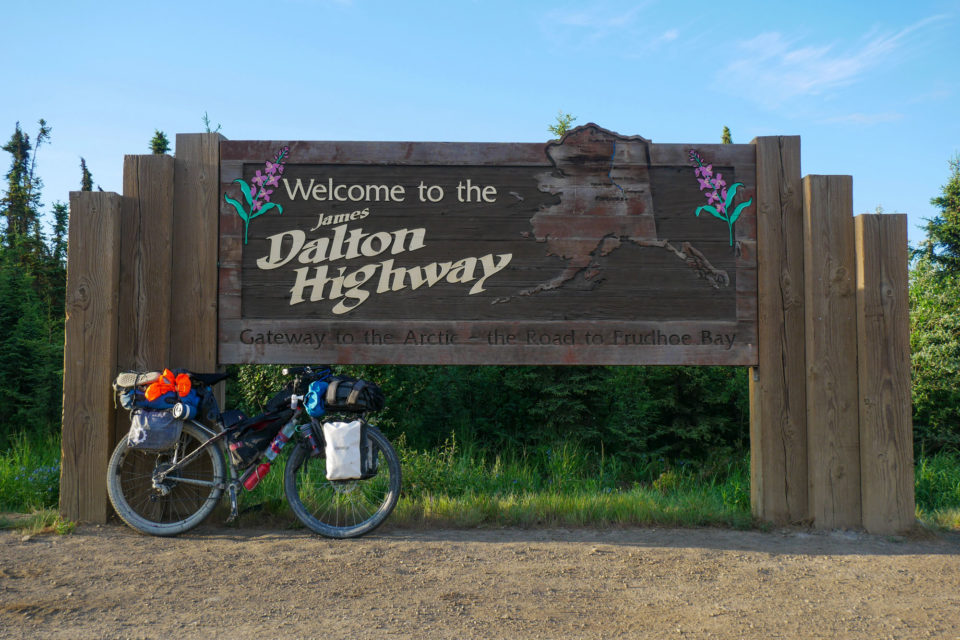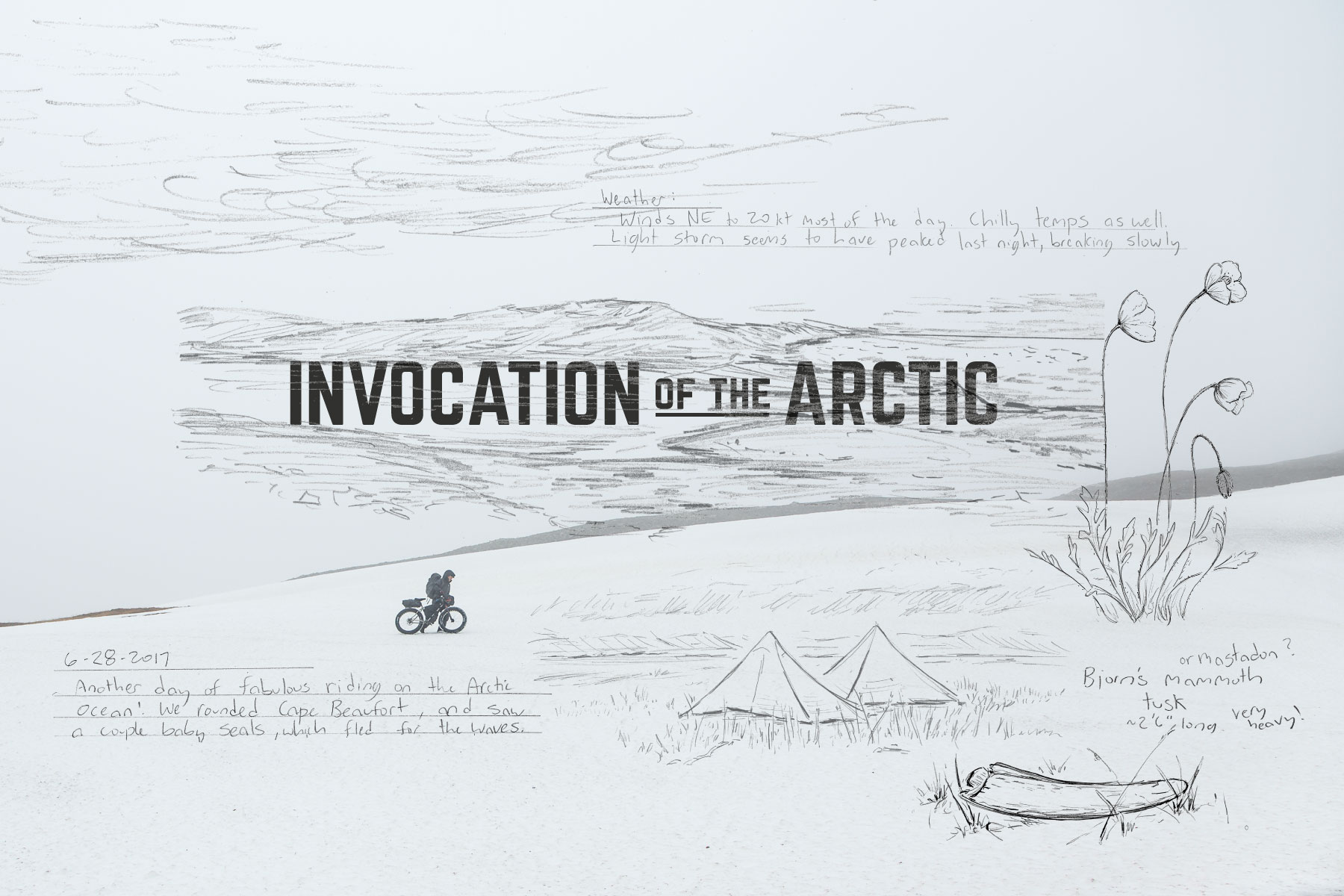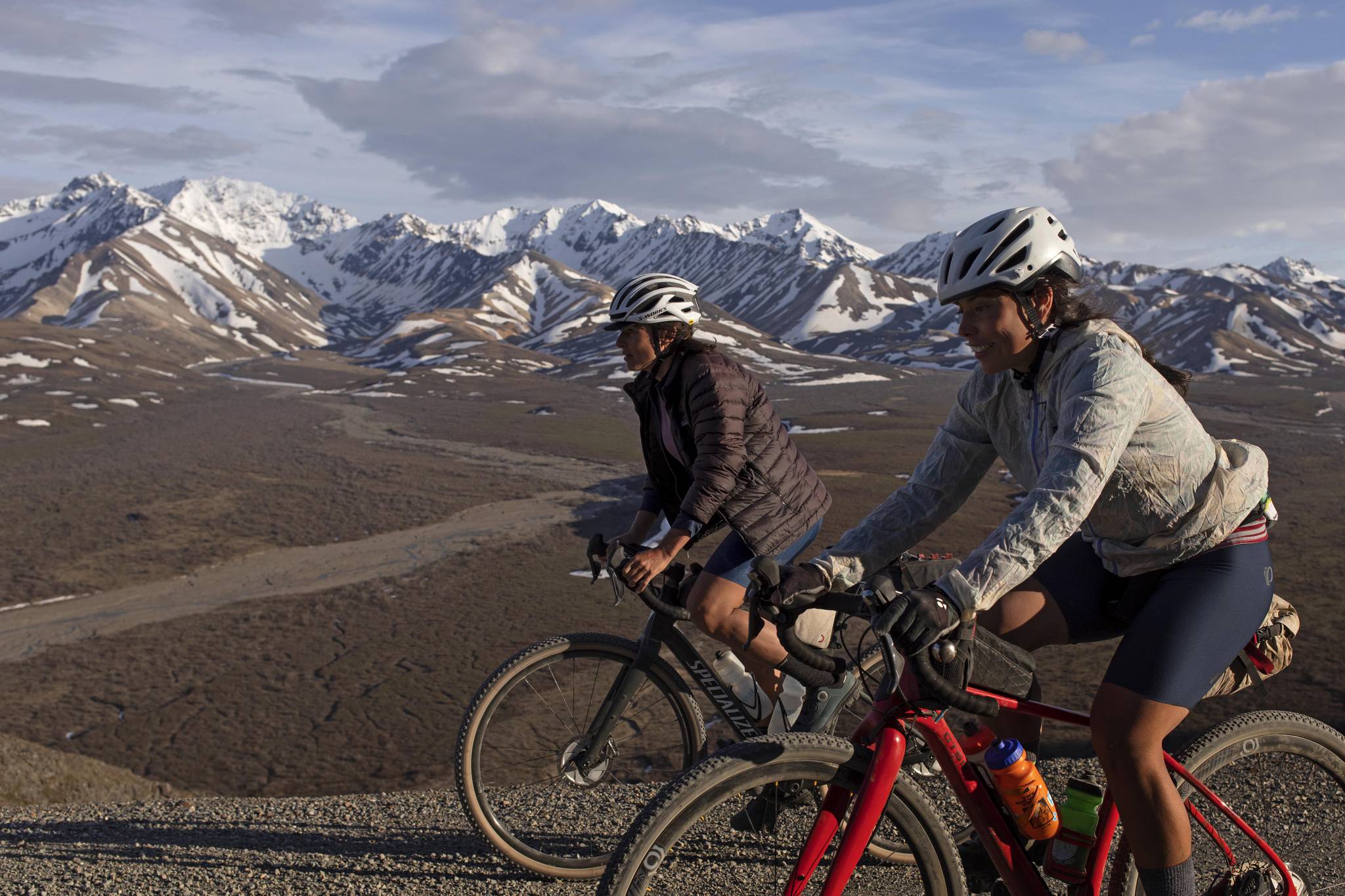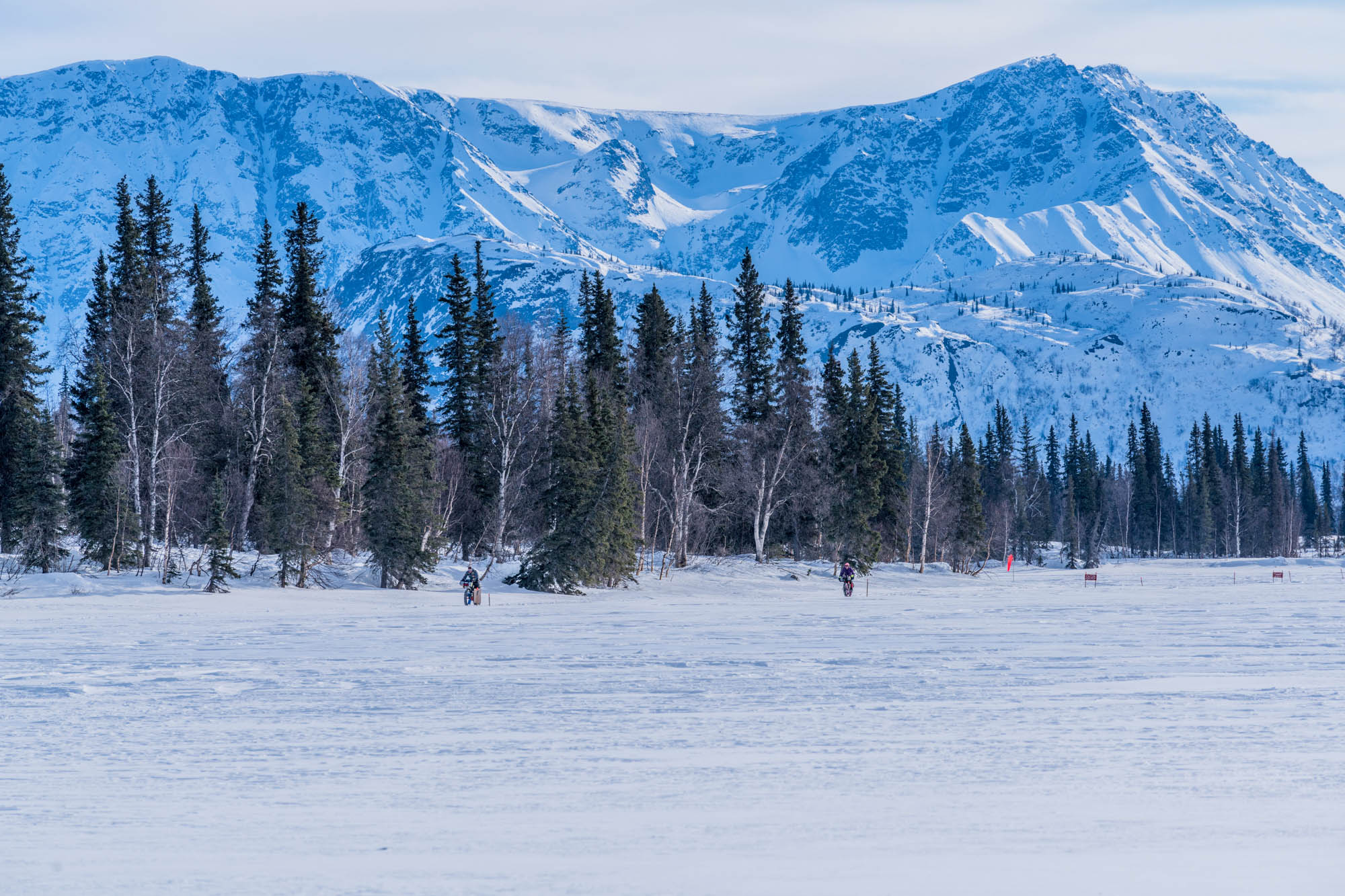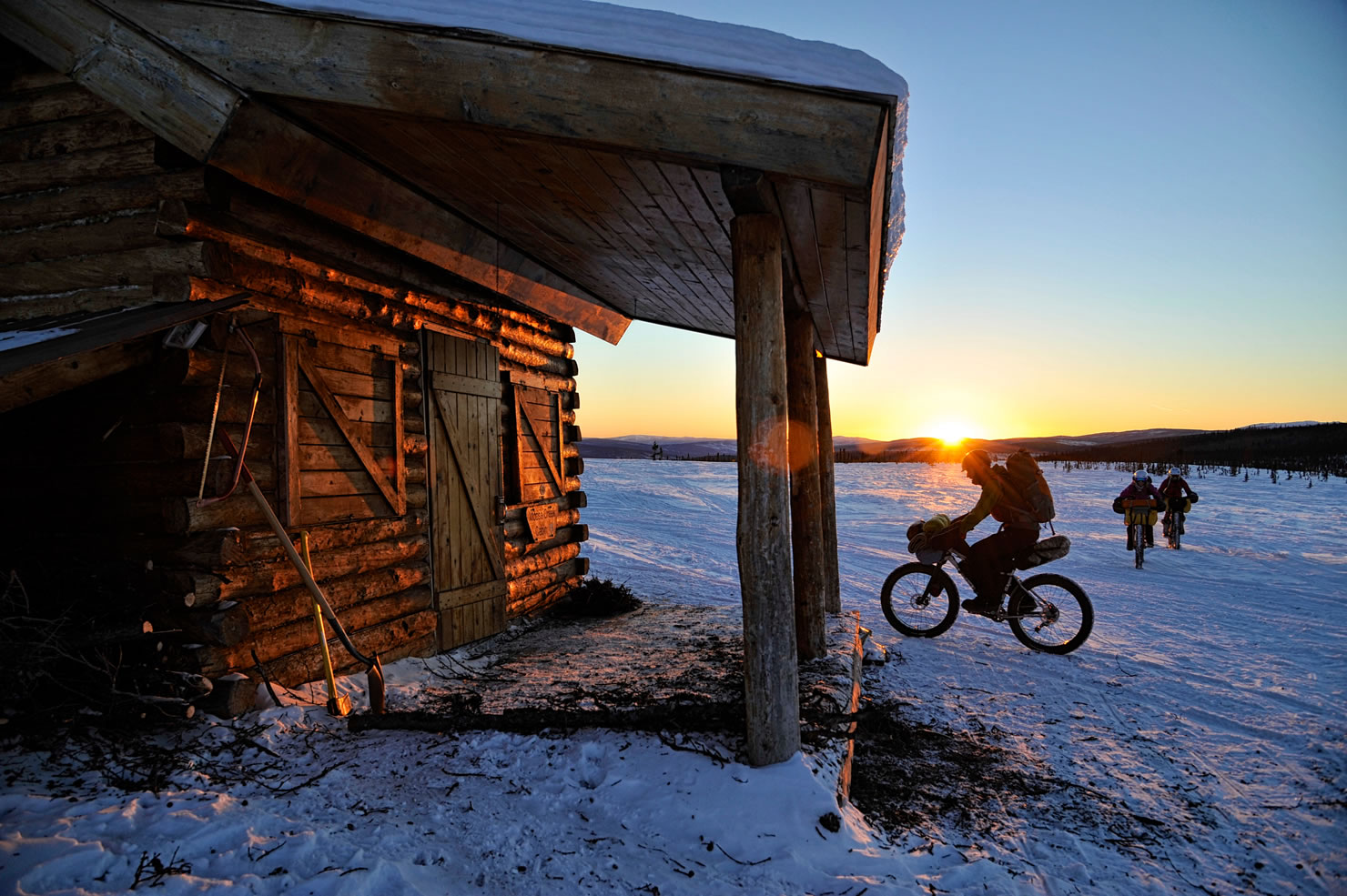Deadhorse Diving Board: Bikepacking the Haul Road
Despite being a relatively inexperienced bikepacker, Brett Woodward took a leap of faith and flew to the top of the world in Deadhorse, Alaska, for an unforgettable three-month ride back south. Find his recap of the rugged and remote Dalton Highway segment of his trip here…
PUBLISHED May 17, 2021
Words and photos by Brett Woodward (@woodwardwheels)
“How much longer you gonna be?”
“Hey, uhh… maybe 15 minutes?”
“We’re closing in 5.”
“Alright, I guess I’m done then. Thanks.”
I grabbed my half-packed gear and wheeled my just-built bike out the door of the tiny airport in Deadhorse, Alaska. The woman in charge of closing the place down for the day wasted no time locking it behind me and turning off the lights.
Well, shit. Here we go.
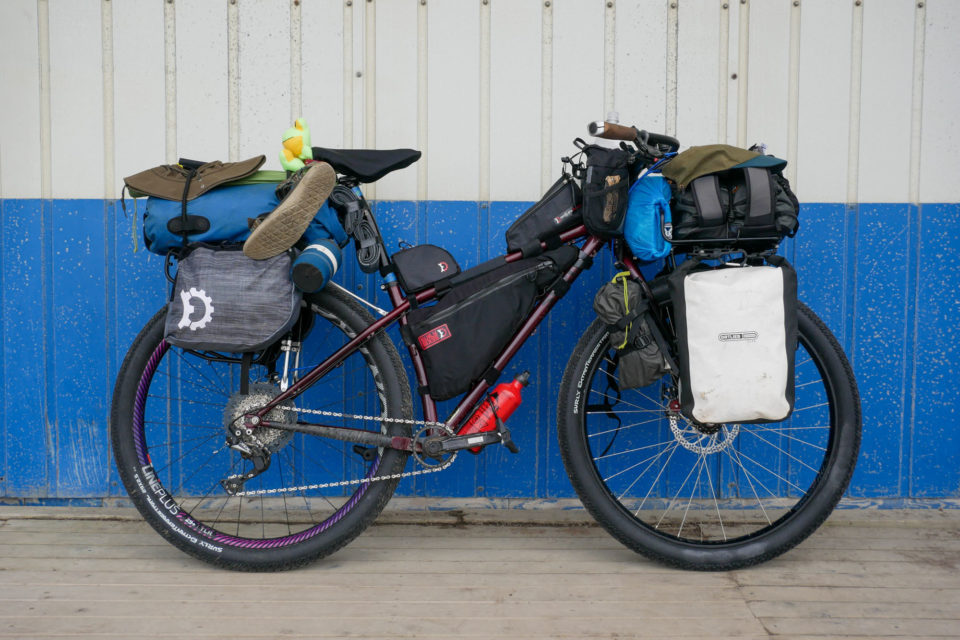
To be fair, I shouldn’t have expected a warm welcome in the most unwelcoming place I’d ever seen. When our plane had dipped below the low-hanging clouds an hour earlier, there wasn’t much to look at. Just a flat, brown expanse dotted with snowdrifts and kettle ponds that dissolved into the fog.
I usually use bikes as a way to be irresponsible, but so far those carefree feelings were nowhere to be found. I was as far north as I’d likely ever be, and I was finding nerves much easier to come by. Fortunately, the first objective for my first big solo bike trip was simple enough: head south on the Haul Road.
The Haul Road ends (or begins) at Deadhorse, a work camp on the frozen banks of Prudhoe Bay, home to what has become the largest oil field in North America. From Prudhoe Bay on the icy shores of the North Slope, crude oil travels to the port of Valdez via the 800-mile Trans-Alaska Pipeline. The James Dalton Highway, more commonly called the Haul Road, is the 414-mile stretch of mostly gravel road that was constructed in 1974 to build and maintain the pipeline’s most northern section.
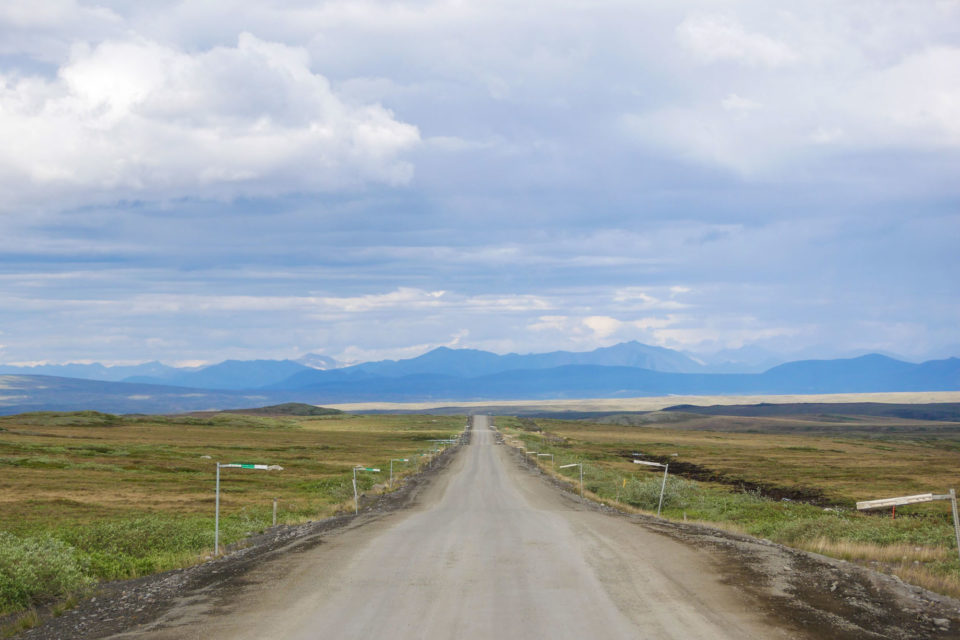
After a dark and difficult nine-month-long winter belonging mostly to truckers and oil field workers, the short summer season attracts curious visitors who are eager to experience the Arctic. For cyclists, the Haul Road’s appeal lies in the beautiful Alaskan terrain it traverses, as well as its status as the most northern road on the continent. As such, there isn’t much in the way of services between Deadhorse and the outskirts of Fairbanks nearly 500 miles to the south. Apart from a couple of truck stops where you can rent a room, grab a bite to eat, and charge your devices, cyclists will experience vast stretches of empty road and scenic vistas.
With my setup complete, I filled my MSR bottle with gas and picked up a can of bear spray and a reflective vest from the Prudhoe Bay General Store. I opted to rent a small room at one of the work camp buildings and leave camping in bear country for the following day.
Someone braver or more experienced would have slept soundly that night, but I was sufficiently intimidated by the task ahead of me. This was only my third bicycle-powered adventure of any real significance. The other two had been much less remote, and I had been able to share the daily decisions and laugh off the challenges with a partner. This time around the only one who would be able to solve the problems, create the motivation, and calm my nerves was myself. Overly dramatic as it may seem, the past few months had felt as though I was inching my way to the end of a diving board above a big plunge. I wanted to jump, although I didn’t really feel like I was the kind of person who would. This kind of thing seemed better suited for the people I followed on Instagram, not me.
The heavy fog had lifted by morning, and the light illuminated the landscape and my confidence with a new perspective. I took a short tour to the oil field to see the fossil fuel industry at work, and to touch the water that fed into the Arctic Ocean. I took my picture at the Prudhoe Bay sign, slapped my sticker up there with the rest, and started pedaling.
The first 70 or so miles south of Deadhorse are pancake flat. The road is often straight as an arrow, with the road markers on either side disappearing out into infinity. One of the only noteworthy events of the first day’s ride was when an arctic fox crossed the road in front of me. My camera was poorly packed, but its inaccessibility gave us a nice moment together, a short 10-second gaze before he resumed his important business.
My first “night” was spent overlooking the Sagavanirktok (Sag) River and thinking everything that moved was a grizzly. My only neighbors turned out to be a pair of curious young caribou and a small group of Musk oxen lounging on the river bank. It was a restless break under the midnight sun, but it felt good to have made some progress.
I spent the next day battling headwinds in the foothills and becoming intimately acquainted with my granny gear. I didn’t have a ton of experience with fully loaded gravel descents and it took some time to get used to the extra momentum and build up my downhill confidence.
Although my mechanical skills can be embarrassingly poor, I was beginning to feel like my bike might actually be up to the task. The dynamo wheel I had built (with some supervision) was working great, and my ridiculously overpacked setup was handling just fine. Sure, an improperly indexed derailleur had chucked my chain into the spokes on the first big hill of the trip, but that’s par for the course with me.
Still, I was pleased with my bike. The Stampus had been born about a year earlier when I gave my Trek Stache’s components to a shiny new Surly Krampus frameset. I had been working at a bike rental business, and thanks to some helpful discounts I was able to upgrade my wheelset and dial everything in for the big ride. It was certainly a hodgepodge of parts, but I’ve never cared too much for aesthetics. I just needed it to do its job.
Aside from inevitable mechanicals (and being eaten by bears), one of my major concerns in my preparation for the Haul Road was traffic. As a cyclist on an active service road, I was very much an outsider in trucker territory. I worried about big rigs thundering past and showering me with rocks. I worried that I’d feel unwelcome and I worried that the traffic would prevent me from enjoying myself and the scenery. Ultimately, none of that was true.
The trucks are massive, to be sure. They are responsible for supplying everything the oil fields need to function. They carry supplies for road maintenance and bring gasoline, food, and heavy equipment to Deadhorse so the big machines can keep turning. However, the frequency in which I encountered them was sporadic enough that they were more of a spectacle than a nuisance. Many times there would be hours between trucks. I came to enjoy watching the dust clouds appear on the horizon, and looked forward to the silence that resumed once they began to disappear behind me. I even got a friendly wave from time to time.
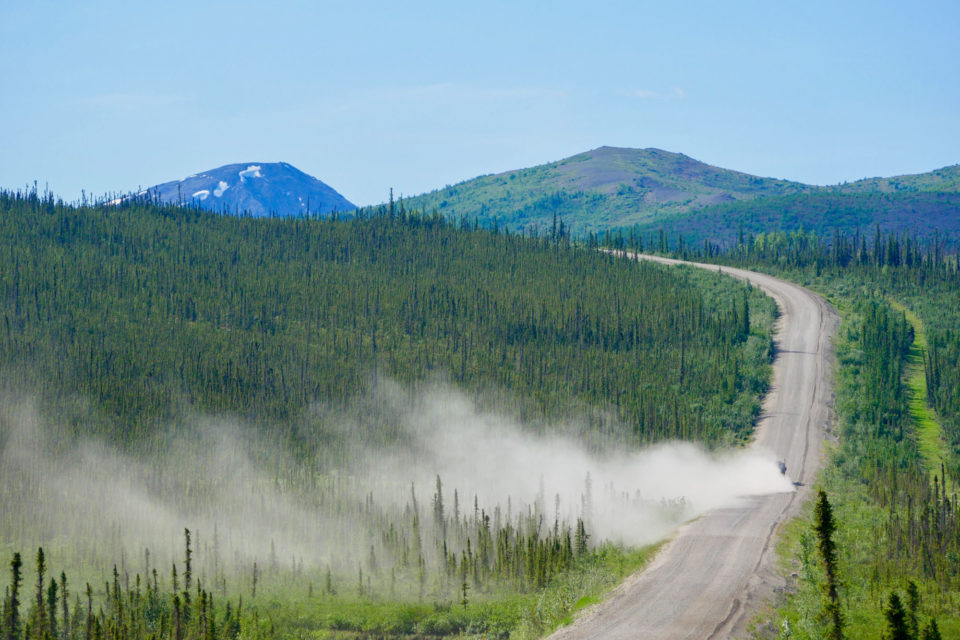
I learned that working the Haul Road was a lucrative, sought-after position, and every trucker I encountered was nothing short of professional and courteous. Unless the terrain where we met demanded otherwise, they routinely slowed down and gave me a wide berth. And I returned the favor by getting out of the way when necessary.
The truckers are in constant contact with one another over the radio, keeping each other aware of road conditions, animal sightings, and the whereabouts of cyclists. On the night before I flew to Deadhorse, I shared space in an Anchorage bar with a woman named Melody who grew up in Fairbanks. She said she often used her own radio to chat with the men out driving the Haul Road. Her older brother was one of those men, but one winter his brakes failed on one of the many icy hills and he lost his life. She told me there was a little cross up there with his name on it, but she had never made it that far north to visit. I told her I would look for it and send her a picture, and she told me to keep her posted with my travels.
Much more prevalent than the big rigs, the pipeline itself was an omnipresent feature of the otherwise barren landscape. There are 12 pump stations that propel oil along rivers, over hills, and through mountain ranges on its way to Valdez. The pipeline follows the Sag River from its mouth at Prudhoe Bay into the foothills of the Brooks Range, and it’s quite the sight. The dichotomy of the pipeline and road cutting through wild spaces is striking, but it’s also painfully obvious that my ride was made possible by an industry responsible for the region’s degradation.
Eventually, the peaks of the Brooks Range came into view and I began to see the progress I was making. I passed the Toolik Lake research station and dropped down into a valley that funneled into the canyon leading to Atigun Pass.
Far older than the Rocky Mountains, the Brooks Range is the northernmost part of the continental divide. It separates the North Slope’s arctic tundra and the boreal forest of the interior, and the creeks and streams originating in the mountains either flow north to the Beaufort Sea or south toward the Pacific. I had never crossed a divide on a bike or even ridden a mountain pass at all for that matter. This was a trip of firsts, after all.
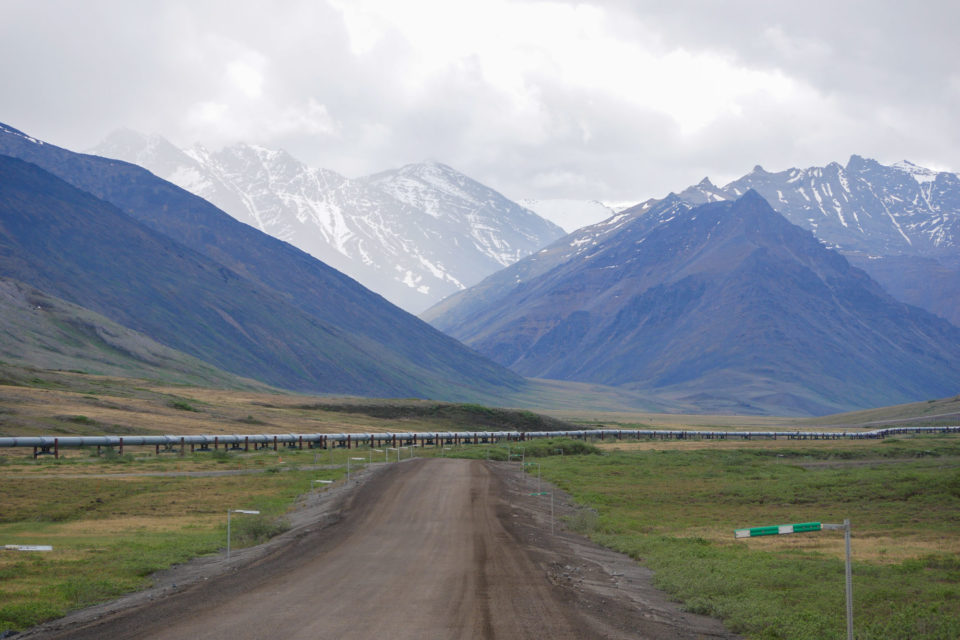
I followed Atigun River past the fourth pump station and into the canyon. Bands of rain softened the road as they rolled through the mountains, but my surroundings were more than enough to keep my spirits lifted. I was planning to save the pass for the next morning, and after winding my way up the canyon and taking pictures, I found a suitable place to camp near the river.
It rained off and on throughout the night and the next morning, and if time made any difference I would’ve said that I got a late start. After about 10 miles, I arrived at the beginning of the pass, and although the canyon so far had been a nice gradual incline, the pass itself was much more formidable. It took me somewhere in the ballpark of an hour to pedal and push my way up, and the chilly rain at the top mandated the shortest of celebrations.
The descent was fast and wet, and I was properly soaked and cold at the bottom. I found some shelter in an abandoned building adjacent to a work camp and made myself a hot meal while I dried out. I thought I was being discreet, but my tracks in the mud gave away my position. Eventually, a friendly trucker named Caleb introduced himself and shared some baked goods he’d been given in Fairbanks. People look out for each other on the Haul Road, and I found that they were more likely to ask if you were okay than worry about some harmless trespassing.
Cyclists don’t take up a lot of space, after all, and that’s one of my favorite aspects about bike travel. The combination of experiencing a landscape so fully and intimately with such little disturbance is unique to human-powered adventures. Less impact, more connection. I think that’s a pretty good combination.
I felt renewed after my break, and the next few hours were some of the coolest I’ve ever spent on a bike. A few miles after Atigun Pass is the Chandalar Shelf, an interesting geological feature that marks the transition between biomes. At the edge of the shelf, I looked down into a new valley, lusher than anything to the north. After a nice descent, I began to see a completely different environment than the tundra I had come from. Browns gave way to greens, and instead of short, hearty bushes, I saw my first real trees since Anchorage.
A favorable gradient, gorgeous mountains, and a steady tailwind propelled me south at speeds I hadn’t yet sustained on the trip. It felt too good to stop, and with rain clouds looming behind me, I didn’t. The 30 or so mile section following the Chandalar Shelf was one of my favorite stretches of the Haul Road, and I barely have any pictures to show for it. Sometimes it’s nice to just live a moment and keep the appreciation for yourself, especially if you’ve got momentum.
That being said, I was stopped in my tracks as I rounded a bend and caught my first glimpse of Sukakpak Mountain. To use an analogy that I would end up living later on in my trip, it was like rolling into a new town after a big ride and finding yourself between a BBQ joint and an ice cream stand. Sometimes you just have to stop. Rules are rules.
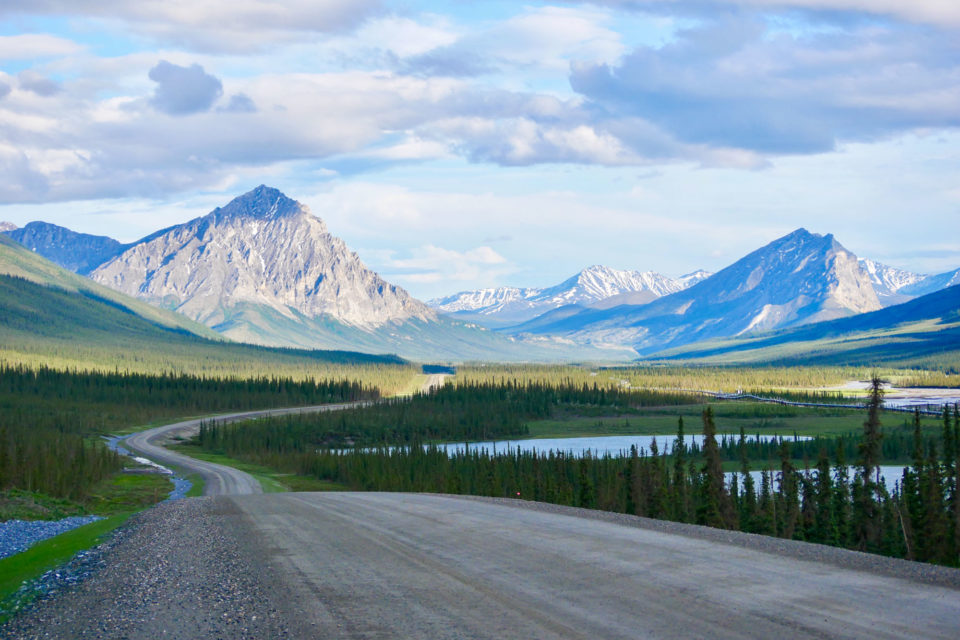
My guidebook told me that Sukakpak is an Inupiat Eskimo word for the deadfall trap they used to hunt martens. Just as it says, when seen from the north, the mountain’s sloped peaks look a bit like a heavy rock or log positioned to fall on some small animal. As a bonus, I found a pit toilet and a nice spot for a tent around the west side of the mountain, and that was too good an opportunity to pass up.
I woke up after another bright, restless night and enjoyed a slow morning below the mountain before setting off. A passing truck gave me the three-horn blast that meant there was a bear up ahead. I never saw it, but it was a good reminder to stay aware.
Grizzlies turned out to be the least of my worries, and a write-up about the Alaskan Arctic in the summer wouldn’t be complete without a few words about the real predators of the Arctic. To say that the mosquitoes up north are horrific might even be an understatement. The long sunny days combined with the millions of kettle ponds kept full by the tundra’s permafrost layer create an ideal habitat, and as such the arctic has one of the most concentrated mosquito populations on earth. The overwhelming swarms are enough to drive herds of caribou over the mountains to the colder climates on the North Slope. These mosquitoes didn’t seem to give a damn about Deet or wind, and they drove me sufficiently crazy at times.
Nothing takes the fun out of camping like sweating your ass off in full rain gear as hundreds (thousands? millions?) of mozzies lay siege. Beautiful creeks that might have been the perfect place to scrub clean and freshen up were often not worth the battle. Although this trip was all about new experiences, peeing into a plastic bag to avoid going outside my tent was not one I originally had on my list. My unsolicited advice is this: if you want to ride your bike on the Haul Road in summer, bear spray is recommended, but a bug net is mandatory.
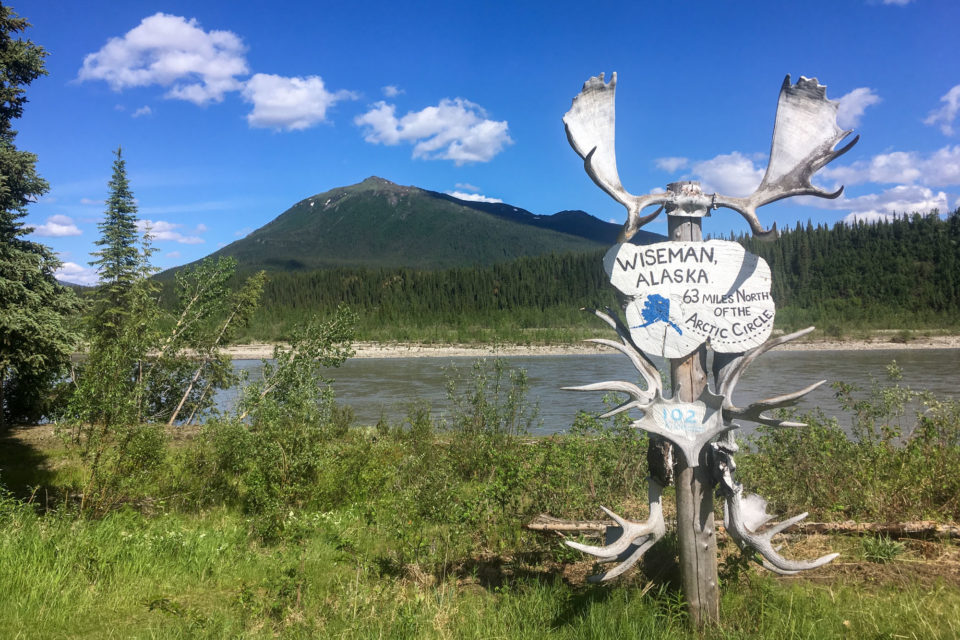
My next stop on my way south was Coldfoot, one of the only places on the road to get a prepared meal and some cell service. Coldfoot is roughly halfway to Fairbanks and due to some tired legs and consistently terrible sleep, I was ready for a rest day. But before I could put my feet up and relax, I took a detour to Wiseman, a tiny “town” about 10 miles north. There are six modest cabins and only a couple of year-round residents. If you make the trip to the far north, I advise you to go and meet Jack, the wise man of Wiseman (my title, not his). He might be busy grinding up a thawing moose leg, but he’ll likely sell you a lynx tooth necklace and maybe even give you a glimpse at what it’s like living above the Arctic Circle all year.
After my visit to Wiseman, I made the short trip to Coldfoot. There’s a cool little restaurant with a buffet and a bar where you can get a burger and a beer if you’ve just finished a long day of trucking and another building where you can rent a room for the night. I was told I could set up my tent for free in the meadow between the two buildings, but only if I stayed clear of the spot where the helicopter sometimes lands. Across the road is the very worthwhile Arctic Interagency Visitor Center, and if you’re driving, Coldfoot is your last chance to fill up before Deadhorse.
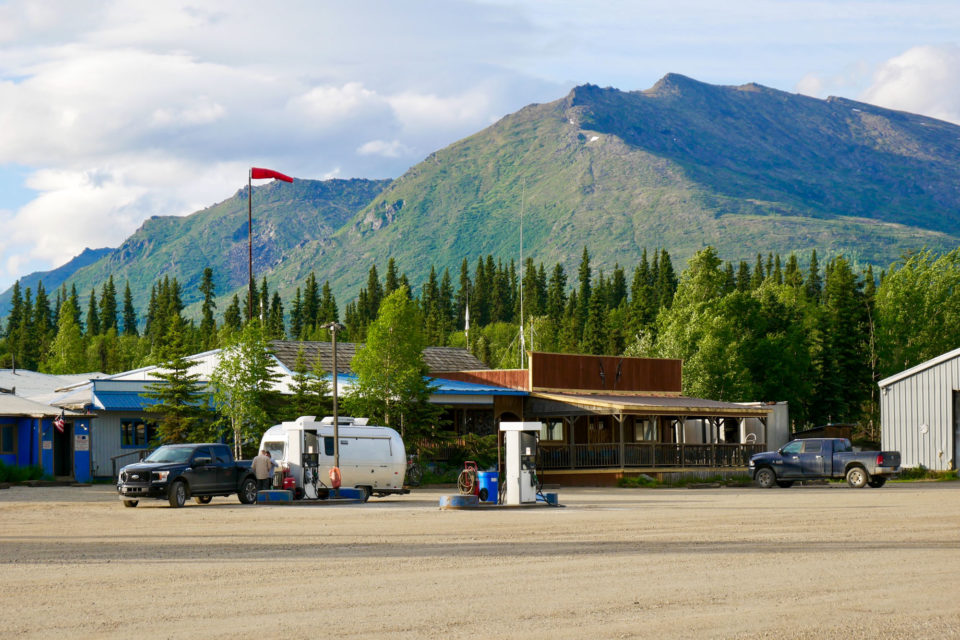
I spent the afternoon stuffing my face at the buffet before enjoying a few beers with a new friend who was on a motorcycle trip across the country. One of my favorite parts of these kinds of trips is meeting other travelers and interesting people and listening to their stories. I spoke with a few other adventurers and workers while I was in Coldfoot.
Bill was finally taking the trip he’d been planning for years. Ken said he had decided he needed to either go back to school or do something weird, and chose the latter. And Dan had recently retired from the military and was now on a final mission to decompress from a lifetime of service. We all had different reasons for doing what we were doing, but for a brief moment, we were in the same place at the same time.
When I left Coldfoot, I left the mountains behind me, but the hills of the interior proved to be a unique challenge of their own. The closer I got to the end of the Dalton Highway, the more difficult it became. The hills are as relentless as the bugs, and the truckers have named all the biggest ones. There’s Sand Hill, Roller Coaster, Beaver Slide, and my personal favorite, Gobbler’s Knob. Each one required patience, my granny gear, and upbeat tunes. Slowly but surely I tackled one after another and inched my way south.
The Haul Road offers plenty of camping opportunities for the traveling cyclist, and I rarely needed to get creative. There is no shortage of pull-outs that often head down to water, and there are even a couple of primitive campgrounds for visitors. My campsites were often quiet and relaxing. With the occasional passing truck in the distance, I enjoyed plenty of silence in which I could explore and take photos. In full rain gear. Can’t forget about the mosquitos.
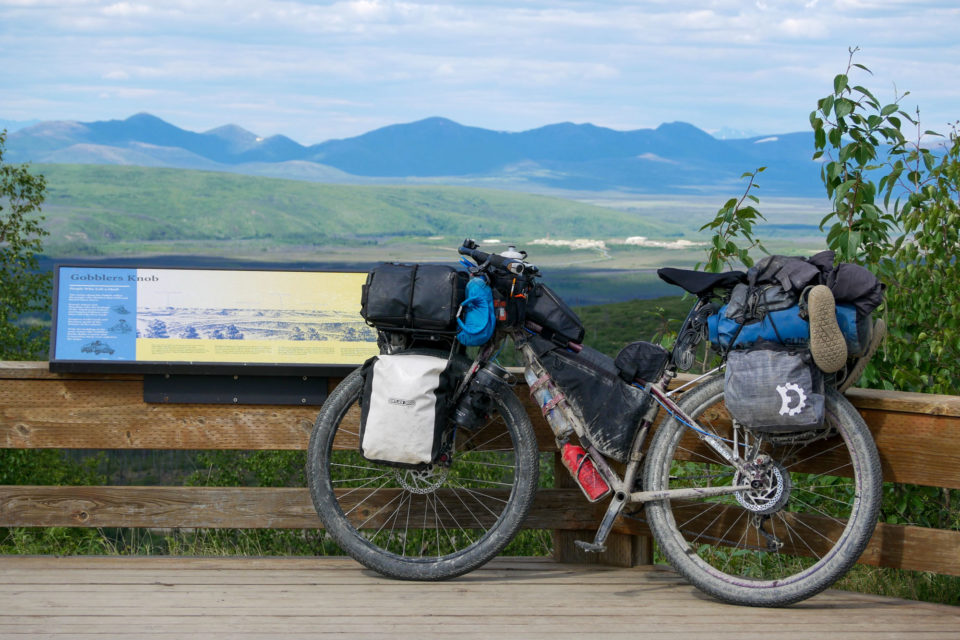
An abundance of clear creeks made water one less thing to worry about, and I never found myself too far from the next chance to fill up. As long as you have enough food (and a bug net for your face), life is pretty good. If you want to save weight you can even mail yourself a box of food to Coldfoot Camp.
The Dalton may be a good combination of wilderness and convenience for tourists, but the balance between human and nature in the Arctic as a whole is unnerving, to say the least. Climate change is on full display up there, and my time on the Haul Road allowed me to see a changing environment firsthand. Our poles are warming faster than our equatorial regions, and the Alaskan Arctic has been warming at twice the rate of the rest of the United States.
I’ve never seen a “normal” amount of Alaskan sea ice, and I haven’t spent enough time up north to really understand just how much the temperatures have increased. But I found few examples of climate change more striking than the sad swaths of charred spruce trees that drooped at strange angles from the combination of wildfires and a thawing permafrost layer. While I can only speak to what I experienced, I saw enough to color my adventure with a little more than just campfire stories. Guilt was not an emotion I had anticipated feeling on this bike trip, but all the jet fuel I enlisted to get me to Deadhorse began to weigh on me.
Although the pipeline has left its mark on the Arctic, its beauty is still undeniable. Visually speaking, the man-made structures are just a blip on the radar of a vast, wild landscape. There are still plenty of spectacular views and interesting animals to see, along with an abundance of bright pink wildflowers like Wild Sweet Pea and Fireweed. From the sea ice of Prudhoe Bay to the mountains of the Brooks Range to the forests and rivers of the interior, the Haul Road kept my eyes (and my legs) busy in the best possible way.
But as impressive as the ride was on the whole, the end of the road was as anticlimactic at the beginning. The mile markers kept telling me that the metaphorical finish line was just up ahead, and I looked for the Dalton Highway sign at the top of every hill I climbed. When it finally did appear, I took an obligatory picture and found myself a mosquito-infested campsite where I celebrated the completion of my accomplishment in full rain gear regalia, sticky and sweaty and tired.
I was still a day’s ride from Fairbanks after my eighth day of pedaling. My progress had been predictably slow, an average of just 50 or so miles a day, but my confidence had grown along with the distance from Deadhorse. My bike and my legs felt capable, and my initial nervousness had given way to the feelings of enjoyment and empowerment that I went searching for on this trip.
Riding the Haul Road was the perfect way to broaden my bikepacking experience. There were significant challenges that made it an adventure, but there were also notable advantages that made it a great place to build myself up for the long journey ahead of me.
My Arctic adventure was the first leg of what would become a three-month ride. I had set out to pedal from Alaska to Mexico, linking up the cool roads I could on my way to the Great Divide Mountain Bike Route. That goal had seemed impossibly difficult when I was politely kicked out of the Deadhorse airport. Now it only seemed difficult. There were more miles and mountains ahead of me, but in a way I felt like I had already arrived. Whatever came next was just a matter of pedaling.
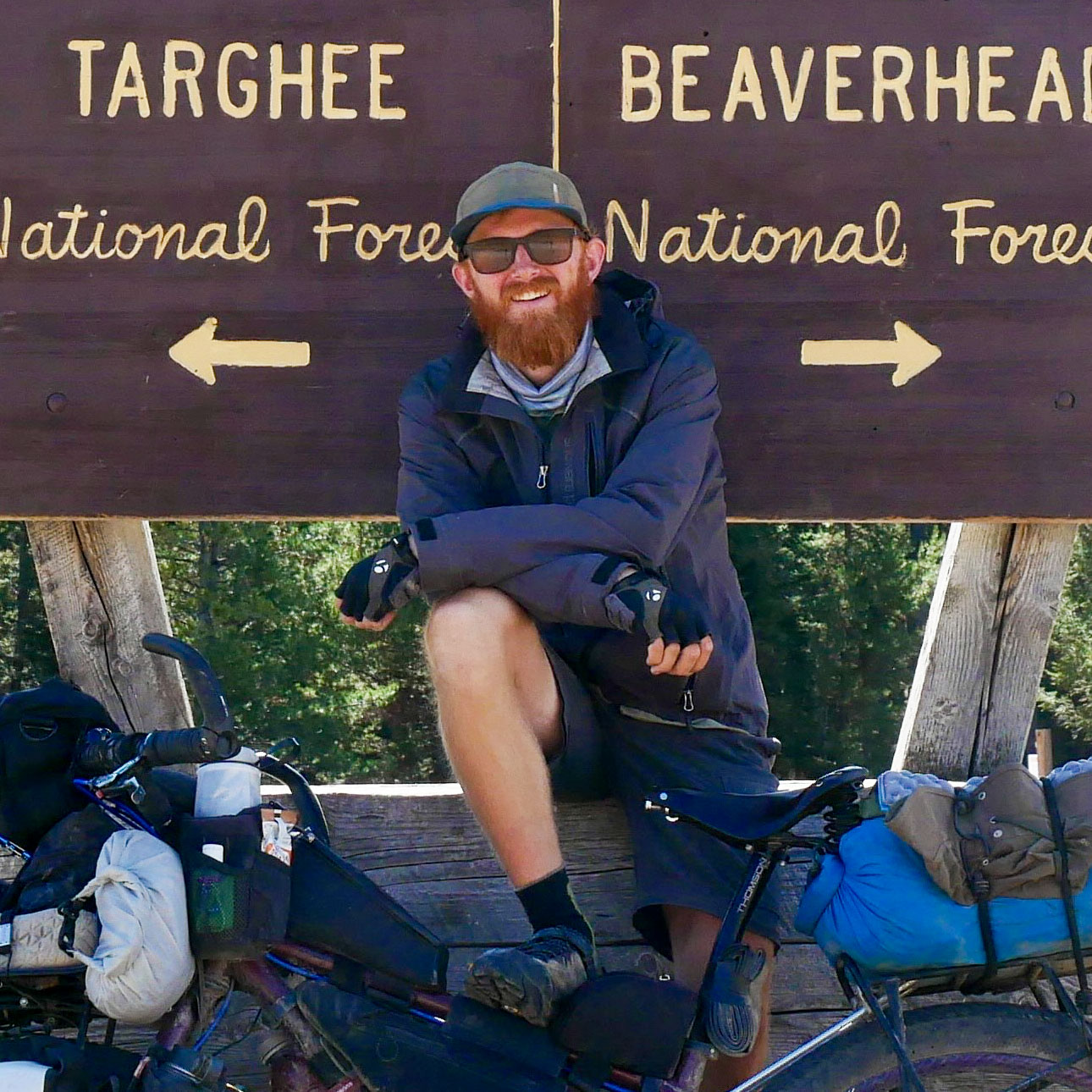
About Brett Woodward
Brett Woodward gained an appreciation for bicycles during his years exploring the sandy trails, dirt roads, and hidden spaces of Nantucket Island. Biking remains his favorite way to experience new places and appreciate familiar ones, and from time to time he posts on Instagram @woodwardwheels.
Related Content
Make sure to dig into these related articles for more info...
Please keep the conversation civil, constructive, and inclusive, or your comment will be removed.







